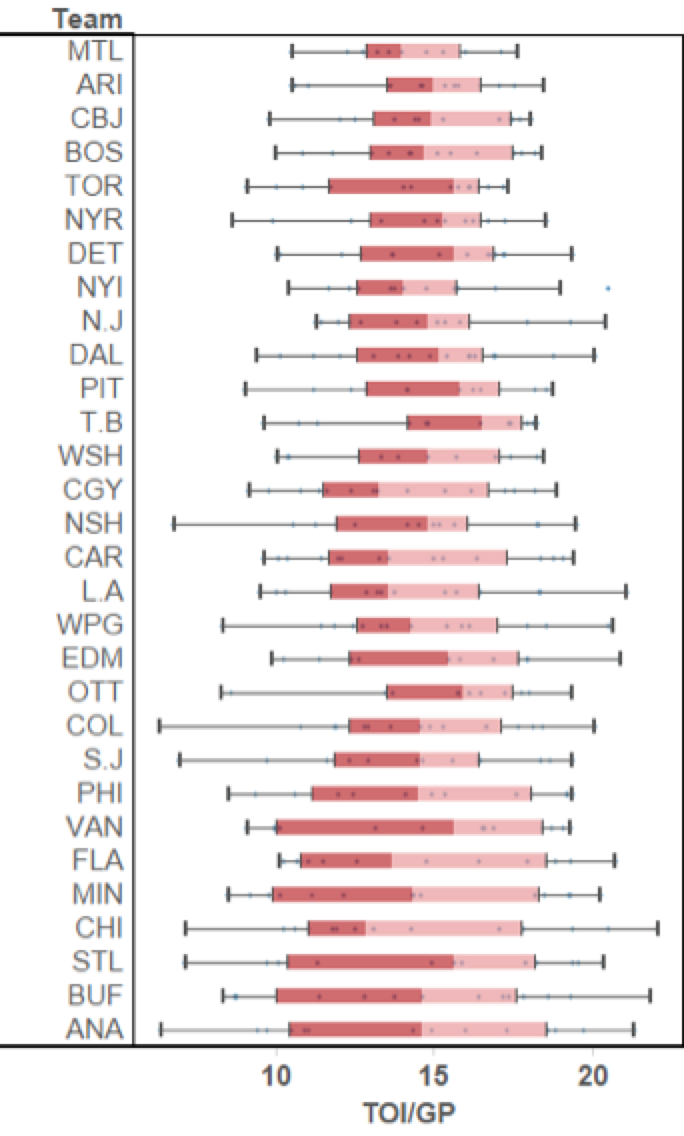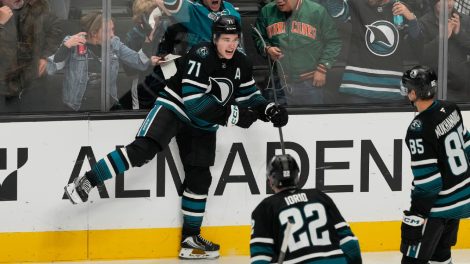The Toronto Maple Leafs have hit the ground running in the first year of forward motion in the youth movement portion of their rebuild. They are playing hockey at a blistering pace, scoring goals in bunches, and providing hockey fans in Leaf Land with the first real rays of hope they have seen in a decade.
The organization will definitely have cautious optimism at this stage of the season, but it has been hard for local media outlets to resist the urge to discuss the tantalizing potential of playoff appearances in the near future.
Outside observers can all see what is working on the score sheet and are aware of the production coming from the talented youth core. Yet it would be beneficial to try and filter through the lights and noise of the hype and identify what takeaways are available at this early stage that give insight to where the team is heading. Similarly, we can try to pinpoint areas for improvement as the team grows and tries to develop into a championship contender.
One of the most intriguing aspects of the Leafs’ early-season progress has been the balance in their forward units. Head coach Mike Babcock has made direct reference to an organizational desire to seek balance across the forward lines and based on how he is spreading ice time amongst his top forwards, the team is one of the most even-keel in the NHL — only four teams have a narrower range in ice time amongst the core of their forward group.
(The following chart displays the distribution of forward ice time for each team in the NHL. The boxes indicate the average TOI range for the middle 50% (2/3 Liners), the whiskers the top 25% (1st Line) and bottom 25% (4th Line) of the roster.)

Rolling all four lines has allowed the Leafs to mitigate any significant dips in offensive production and they lead the NHL in Score and Venue Adjusted Expected Goals For per 60 (3.26) and Scoring Chances per 60 (12.52) after 20 games. Their explosive team speed and youth has led to some of the most exciting hockey in the NHL this year, particularly when we factor in that they rank 27th in both Score and Venue Adjusted Expected Goals Against per 60 (3.02) and Scoring Chances Against per 60 (10.91).
The high-flying Auston Matthews-William Nylander combination was productive early, generating 10 goals and 19 points in the first six games of the season. The rookie top liners have gone relatively cold since, producing a total of only two goals and eight points in the next 12 games before Matthews broke out of his slump against New Jersey on Wednesday night. Fortunately, due to the balance in the lineup, the offensively oriented Tyler Bozak-James van Riemsdyk-Mitch Marner line picked up where they left off. Despite producing only four goals and 10 points through the first six games, that trio has rattled off 15 goals and 37 points in their last 14 games.
Meanwhile, Nazem Kadri has produced at a vastly more consistent rate this year in comparison to his struggles last season, posting three points in his first five games, five more points in games 6 to 10, three more in games 11 to 15 and finally four more points in games 16 to 20. Recently, wingers Leo Komarov and Connor Brown have been adding to the offence as Babcock had hoped when he promoted Brown from a fourth-line role. These two – who are more defence-minded forwards — have combined for five goals and 12 points in the past 11 games the Leafs have played. All of this despite facing the top forward groups from the opposition.
So with the offence producing reliably, that leaves the question of defensive performance.

On this week’s podcast, Luke Fox of Sportset joins Rory Boylen and Ryan Dixon to discuss the Canadian NHL teams.
LISTEN NOW | Puck drop | iTunes | Podcatchers
Suffice to say, thus far the Leafs have some serious issues on the back end. Despite obvious contributions from the likes of Jake Gardiner and Morgan Rielly, who again are both near the top of the Leafs D in ice time and performance, there remains a mixed set of contributions from the rest of the blue line.
Historically, Babcock has relied heavily on veterans in leadership roles and thus has consistently ensured one or both of Matt Hunwick and Roman Polak are in the lineup. Unfortunately, neither player has been particularly effective in a shutdown role, and both have largely been relegated to a third pairing role for much of the year. Martin Marincin and Connor Carrick have both had very solid stretches in the early going, but defensive lapses have earned them trips to the press box when the coaching staff has felt it necessary.
Interestingly, Babcock has spent much of the early portion of the season singing the praises of rookie Russian defender Nikita Zaitsev. Yet for all his pedigree in playing for top KHL side CSKA Moscow, being a KHL all-star, and playing top pair minutes at the World Cup for Russia, Zaitsev has struggled at times as he adjusts to the higher paced game in the NHL.
Last season Emmanuel Perry of Corsica.Hockey began working on collecting data on NHL-logged highlight events. His website now has a searchable database linked to the NHL website that allows us to connect video of high-danger scoring chance events and goals to individual skaters who are present on the ice. Using the count of highlight-reel events and the ice time for all of the regular Leaf defenders this season we can paint an interesting picture of production and defensive responsibility thus far.
| Defender | TOI | Highlights For | Highlights Against | HF/60 | HA/60 | HF% | xGF% |
|---|---|---|---|---|---|---|---|
| Rielly | 457:31 | 27 | 34 | 3.54 | 4.46 | 44.26% | 47.81% |
| Zaitsev | 440:20 | 26 | 33 | 3.54 | 4.5 | 44.07% | 49.94% |
| Gardiner | 391:38 | 39 | 27 | 5.97 | 4.14 | 59.09% | 63.16% |
| Carrick | 319:53 | 27 | 23 | 5.06 | 4.31 | 54.00% | 63.70% |
| Marincin | 264:55 | 17 | 24 | 3.85 | 5.44 | 41.46% | 45.31% |
| Polak | 265:15 | 14 | 23 | 3.17 | 5.2 | 37.84% | 38.72% |
| Hunwick | 207:49 | 13 | 23 | 3.75 | 6.64 | 36.11% | 37.03% |
*all data obtained from Corsica.Hockey*
From the table we can see why it makes sense that Marincin has occasionally been relegated to the press box if he is being evaluated purely by visually tracked scoring chances. It also becomes obvious why Polak and Hunwick have been firmly cemented into a third pair role as they clearly have been overmatched in their usage so far.
What the chart ignores though, is that Marincin has spent a fair number of his 14 games playing on the right side as a left-handed defender – a setting Babcock has regularly stated he prefers to avoid putting defenders in. Marincin also averages more time on the penalty-kill per game than any other Leafs defender, where many of the highlight attempts against are showing up. Polak and Hunwick are next on the list of PK ice time, so that would be a significant factor in the defensive results observed for all three skaters.
If we focus purely on percentages it appears Carrick and Gardiner are doing far more to drive play than any other duo, but clearly most of this stems from offensive production. What becomes more apparent if we focus on the number of highlight plays against each defender is that Zaitsev and Rielly have been working to limit dangerous chances against despite logging the heaviest minutes amongst the defensive group. Their tough opposition could also be used to explain their less impressive offensive production in comparison to Gardiner and Carrick.
What has to be most concerning to the Leafs management group is that they clearly need to improve on the defensive side of the ledger. The veteran stop-gaps they are relying on in Polak and Hunwick aren’t contributing at an effective level, and an upgrade is necessary if they hope to progress further.
Given the fact that the likes of Peter Holland, Josh Leivo, Nikita Soshnikov, Brendan Leipsic, Kasperi Kapanen, Kerby Rychel, and more are waiting for their chance to make an impact at the NHL level, the Leafs can likely afford to part with some of their forward depth in an effort to upgrade the blue line. The team already acquired and lost Seth Griffith on waivers this season, so they clearly have more depth than they know what to do with up front.
It will be interesting to see if the Leafs can make an impact move via trade this season in order to shore things up, particularly given that maneuvering around the expansion draft will be necessary for some teams carrying a lot of blue line depth. The rebuild is going faster than expected and the kids are ready to go, but the foundation isn’t set yet and more change is on the horizon. No matter how all of this plays out, it will continue to be one of the most intriguing years in the history of the Toronto Maple Leafs.








